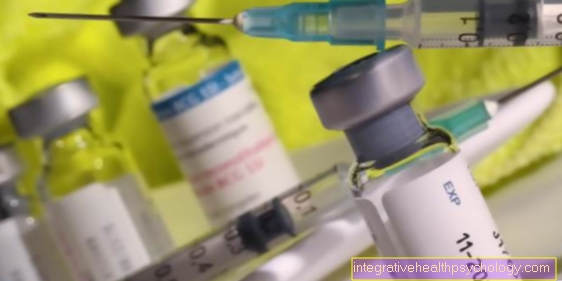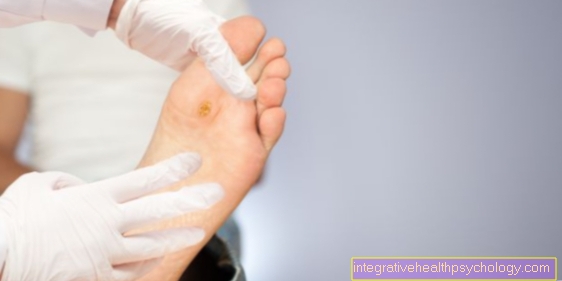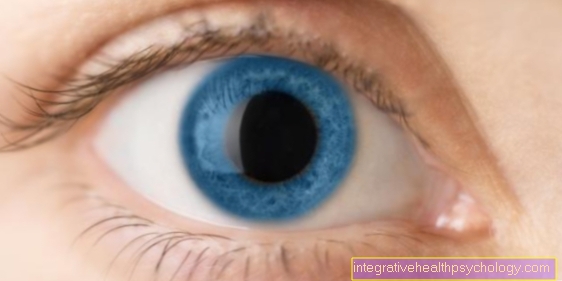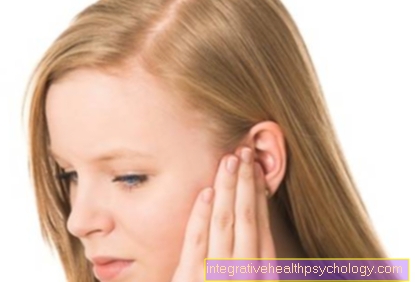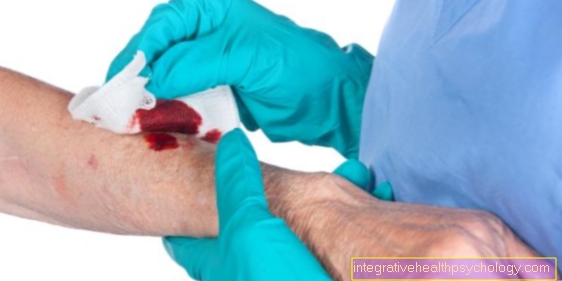Pus in the ear
Definition - what is pus in the ear?
Pus - also known as pus in medicine - occurs primarily in bacterial infections of the ear, but can of course also occur in any other infected part of the body (such as skin or wounds).
With some bacteria there is particularly strong pus formation. Pus consists mainly of proteins and disintegrated tissue. The tissue breakdown is caused by enzymes in the bacteria and by white blood cells such as granulocytes. The white blood cells and bacteria - both alive and dead - are thus also in the pus. Usually pus is whitish-yellow in color. In some cases a little blood may be mixed in.
Also read: Abscess on the ear

CAUSES of pus in the ear
Different parts of the ear can be infected and thus the origin of the pus in the ear.
- On the one hand, this can lead to inflammation of the external auditory canal (otitis externa). This often leads to a visible discharge of pus.
- On the other hand, an infection of the middle ear (otitis media) can lead to the formation of pus and, if the eardrum is additionally injured, it can cause suppuration in the ear.
- An inner ear infection (labyrinthitis), which can also develop from an otitis media, is often accompanied by the formation of pus.
- Infected injuries or foreign bodies can also be the cause of a purulent infection.
- Another cause of pus can be pimples or boils (abscess).
The inflammation of the ear, which leads to the formation of pus, is in most cases caused by bacteria. If the infection is triggered by viruses or fungi, it actually only forms pus if there is a superinfection with bacteria in the course of the disease.
Otitis media
A purulent otitis media occurs especially in the winter months. It usually arises from an ascending infection of the upper respiratory tract. Children are therefore mainly affected, as the mouth-ear connection (eustachian tube or tuba auditiva) is shorter. Middle ear infections are often triggered by mixed viral and bacterial infections.
If a bacterial infection occurs, pus can also develop in the middle ear. Pus drains from the ear when the eardrum ruptures or the inflammation spreads to the external ear canal. In most cases, the tear in the eardrum will close again within 1-2 weeks.
Please also read: Otitis media
Accompanying SYMPTOMS
General symptoms such as fever and fatigue can occur during otitis media. Decreased hearing and dizziness are often noticeable. The general condition is also severely impaired in most cases. The common pain in the ear can also radiate and cause a headache.
A tear in the eardrum can lead to otorrhea. This means that pus is visibly flowing out of the ear. Since an otitis media is often caused by ascending infections from the throat, nose and throat, difficulty swallowing, sore throat or runny nose can occur or precede them. Inflammation of the external auditory canal causes tenderness on the ear. Here, too, the swelling of the ear canal can lead to hearing loss. If a foreign object has entered the ear and clogs the ear canal, the affected side can become hard of hearing.
Read more at: Ear canal inflammation
With Pain
Pain in the ear or around the ear suggests an ear disease. The ear is particularly sensitive in the middle and outer area. Very severe and stabbing ear pain is common with otitis media. Inflammation of the external auditory canal is more common in adults and adolescents. The cause is often too frequent cleaning of the ear canal with ear swabs. These irritate the lining of the ear. In addition to unpleasant pain, this irritation can also lead to the formation of pus.
In addition to blistering on the ear or in the ear canal, an ear herpes (zoster oticus) leads to severe pain. This also leads to a secretion of the vesicles, which can be visible in or on the ear. However, this fluid is not pus but a clear vesical fluid, which, however, appears yellowish due to ear wax and can imitate pus.
Please also read: Herpes zoster oticus
Without pain
On the one hand, chronic otitis media can be pain-free but accompanied by the formation of pus. In some cases, those affected have "got used" to the pain and no longer perceive it as such. The secretion that flows from the middle ear into the external auditory canal is usually creamy-yellow or slimy. It can smell bad or it can be odorless. Chronic otitis media can also be associated with hearing loss, dizziness and ringing in the ears (tinnitus).
On the other hand, pus flowing out of the ear without pain can be a tympanic effusion (seromucotympanum). A ventilation disorder in the ear causes secretion to accumulate in the tympanic cavity. If there is an infection and pus formation in the secretion, pain is often added. The tympanic effusion is accompanied by a feeling of pressure in the ear and hearing loss. In adults, further diagnostics should definitely be carried out, since in addition to runny nose, throat infections and sinus infections, cancer of the nasopharynx (nasopharyngeal carcinoma) can also be responsible for the ventilation disorder.
Our next article could also be of interest to you: Treatment of otitis media
With difficulty swallowing
An inflammation of the throat (pharyngitis) or tonsillitis (angina tonsillaris) can also spread to the ears and cause an otitis media there. Especially when bacteria such as streptococci have triggered the inflammation in the throat, a purulent otitis media can follow. Acute tonsillitis can cause sore throats as well as swallowing pain and disorders. It can also lead to lumpy speech and bad breath (foetor ex ore). Schoolchildren in particular are affected by tonsillar angina. But it can generally occur at any age.
Pus runs out of the ear - what's behind it?
Inflammation of the ear can be accompanied by secretion of pus from the ear (otorrhea).
- In most cases, the inflammation is right in the ear canal. This often occurs when the ear canal is manipulated (for example by frequent cleaning with ear swabs).
- Sometimes, however, the eardrum tears due to a purulent inflammation in the middle ear. Some of the pus can also contain blood. Sometimes it comes to a smelly pus discharge (fetid otorrhea). This typically occurs with an infection with the bacterium Pseudomonas aeruginosa.
In any case, a pus discharge should be assumed to be a pathological occurrence in the ear. Pain is almost always present here. If otorrhea is diagnosed, an ENT doctor should be consulted, who will investigate the cause.
Also read: Inflammation of the ear
LOCALIZATION
Pus in the ear hole
Pus in the ear hole often appears after piercing an ear hole for earrings. Since the piercing of the ear tissue creates a "wound", it can become infected and fester due to the penetration of bacteria. These can get into the open tissue either through uncleaned material during the lancing or afterwards.
In addition, there is usually pain, redness and swelling of the ear.The earring should be removed urgently in the event of suppuration of the ear hole in order to prevent further irritation of the ear. Daily cleaning with disinfectant solutions should then be carried out. If, in addition to the pus, a fever occurs, antibiotics should be taken in the form of tablets.
Also read: Inflammation of an ear hole
Pus behind the ear
In harmless cases, pus behind the ear is a pus-filled or scratched pimple.
However, it can also be an inflammation of the mastoid process behind the ear. This is the noticeable, protruding bone behind the ear. In addition to the formation of pus, severe ear pain, swelling, reddening and overheating of the mastoid can occur. Since this is a dangerous clinical picture with complications such as hearing loss, meningitis or brain abscess, treatment should be carried out in hospital. In addition to pain therapy, intravenous antibiotics (administered directly into the vein) should be given. If symptoms do not get better within the first two days, or if a large boil (abscess) becomes visible, surgical treatment with evacuation or removal of the mastoid should be performed.
Read more on the subject at: Swelling behind the ear - what are the causes, mastoiditis - therapy
DIAGNOSIS of a purulent ear
The doctor arrives at the diagnosis by asking questions about symptoms and progression at the beginning. This is followed by a physical exam, looking into the oral cavity and ears, palpating lymph nodes, and listening to the lungs.
The ear is examined using an otoscope. The otoscope can be used to assess the ear canal and eardrum and thus find out where the infection is coming from. If it is an otitis media, one often sees a reddened, bulging eardrum. If the eardrum ruptures, pus drops may be seen on the eardrum. With external inflammation of the ear canal, pus can be found in the ear canal.
Please also read: Torn eardrums - you should do this!
THERAPY of a purulent ear
- An otitis media is mainly treated symptomatically. This means that the patient should drink a lot to thin the mucus that has formed. It is also important to use decongestant nasal drops to restore ventilation in the ear. Therapy for the pain is usually carried out with paracetamol or ibuprofen.
- Pus formation in the ear is mostly due to bacterial infections which must be treated with oral antibiotic treatment. In the case of otitis externa, the ear canal should be cleaned. If pus develops, antibiotics should be applied to the ear canal to treat bacterial inflammation.
- If the ignition is triggered by the penetration of a foreign body, it must be removed beforehand.
- If a tympanic effusion is responsible for the pus formation, antibiotics should also be given here. If the secretion does not drain, a ventilation tube is inserted into the eardrum.
Are you interested in this topic? Read more about this under: Treatment with antibiotics
Which home remedies can help?
There are several home remedies that can be used for otitis media. On the one hand, a so-called onion compress (finely chopped onion in a linen cloth) can be placed on the ear. The onion has an antibacterial effect. Chamomile also has an anti-inflammatory effect. For example, a bag of chamomile tea can be infused. The tea is drunk, the bag is squeezed out and placed on the affected ear. The tea can therefore also be effective against bacterial inflammation of the external ear canal. Heat can relieve the pain of otitis media and aid healing. This can be applied with a red light lamp or, for example, with warm potato mash in a linen cloth.
You can find more at: Treating otitis media
When do i need antibiotics?
Since pus in the ear usually suggests a bacterial cause, antibiotics should always be used. In the case of external inflammation of the ear canal, the antibiotic is usually applied directly into the ear canal.
If the person affected has a severe weakening of the immune system (for example due to a disease such as HIV) or has diabetes (diabetes mellitus), antibiotic therapy should be given in tablet form.
In an otitis media - which is usually caused by viruses - pus also indicates a bacterial process. Further indications of a bacterial ear infection are a strong feeling of illness with a high fever, discharge of pus from the ear and no improvement in symptoms within the first 2 days. Then antibiotic treatment should be given.
What are the best antibiotics?
Which antibiotic is used depends on the bacterium causing the infection. The structure of the bacteria differs. For example, there are differences in the structure of the bacterial wall. Since antibiotics have different points of attack, certain antibiotics only work on certain bacteria.
- An otitis media is often Streptococcus pneumoniae or Haemophilus influenzae. The antibiotic of choice is what is known as amoxicillin.
- If the external ear canal is affected, another bacterium is often responsible for the infection: it is often a Pseudomonas aeruginosa infection. Quinolone antibiotics (e.g. ciprofloxacin) are then used.
In any case - especially if there is no improvement in symptoms after taking the antibiotic - an ear swab should be taken. The bacterium causing the infection is reliably determined. At the same time, a so-called antibiogram is made, which shows which antibiotic is effective against the bacterium.
DURATION of the healing process
Since the formation of pus in the ear can have different causes, the duration of the disease is different. However, with the right treatment, healing should occur within one to two weeks.
If an otitis media occurs for a long time or returns at certain intervals, it is a chronic inflammation. Usually the eardrum is damaged. This eases inflammation of the ear. The treatment is then carried out by restoring the eardrum (tympanoplasty). In most cases, healing will then occur. In some cases, however, recurring inflammations are recorded despite tympanoplasty, which must be treated again and again.
Please also read: chronic otitis media
How contagious is pus in the ear?
In addition to dead bacteria, there are also living bacteria in the pus. Therefore, the pus in the ear is also contagious.
The infection can arise, for example, through hand contact with the pus. However, this does not have to lead to an infection of the ear, but can also trigger infections of the throat area, respiratory tract or even the skin. How many bacteria are needed to trigger an infection depends on the type of bacterium and its ability to trigger a disease in the body (virulence). The strength of the human immune system also plays a role in determining whether an infection can develop easily or severely.
You might also be interested in our next article: How contagious is an otitis media?





